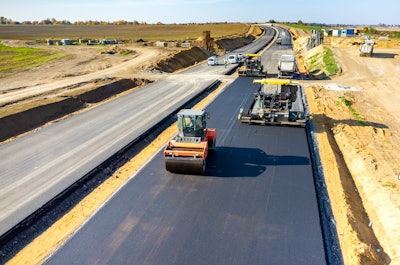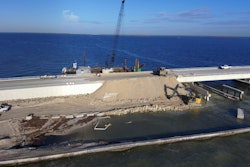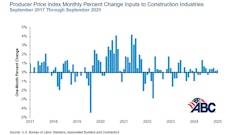
Today, the National Asphalt Pavement Association (NAPA) held one of its regular briefings, where they cover many topics relevant to their members and to the industry as a whole. Jay Hansen, Executive Vice President of Advocacy for NAPA, shared a brief presentation outlining some of the impacts and reverberations felt by the road building industry from the dynamic duo pieces of legislation, the Infrastructure Investment and Jobs Act (IIJA) and the recently adopted Inflation Reduction Act (IRA).
The States of the Union
Before Hansen presented the financial details, NAPA President Audrey Copeland shared the results of an "informal survey" conducted by NAPA in the month of August. This survey was in regards to the status of state Departments of Transportation (DOT) projects and whether they were experiencing delays or cancellations due to either, "inflation, supply chain, and/or labor issues." The results offered vital contextual evidence for the climate of the industry as it stood quite recently and just as the IRA was signed into law.
Forty-one state DOTs were surveyed by NAPA, though five did not respond by the time the analysis was concluded, ~33% of those reporting states said they were dealing with projects either postponed or cancelled due to one of those three possible disruption factors (inflation, supply chain, labor). One-third of the country's DOTs dealt with some of the same production problems and disruptions reported by so many other industries. Another 8% of states reported that there was potential for delays and/or cancellations for reasons not directly connected to the three above.
"This is a very informal survey, but it does kind of give us a pulse of what's going on across the nation in terms of the impact of inflation as well as the bill[s]," Copeland said. "In terms of supply chain issues, a lot of the reporting was for pavement marking materials and steel rather than things that impact the actual asphalt mixture. However, two states, Florida and Georgia, are experiencing delays with aggregates."
The silver lining to this information is that the 50% of states responded by saying that they were not currently cancelling or delaying any DOT projects. This group makes up the majority portion, and still reflects positively, despite having no responses at all from fourteen states all together.
Three Early Impacts
1. Big Increases to Usable Federal-AID for Highway Projects
As Jay Hansen began his remarks during the broadcast, he shared a link to a document on the NAPA advocacy website that compares the budgetary figures in an easy-to-digest spreadsheet, that details out the year-to-year differences (2021-2022) in funding available obligations, including individual state breakdowns. Compared to this time last year, there is an overall increase of ~15%, more than $8.03 billion, available to the states. Yet, despite these increases, inflation appears to be thwarting at least some of the gains.
Audrey Copeland explained, "In some cases...cost increases [were] upwards of twenty to thirty percent. And then in terms of the IIJA, the increased funding is really not able to make up for the impact of inflation. And so it is evening out, but inflation is definitely eating into it."
2. New Federal Grants for Businesses
As was previously reported here, under IRA provisions, the federal government is taking a more motivational approach to the private sector. Rather than punitive measures for violating or not meeting newly imposed standards, there are incentives for those businesses that want to upgrade. The "Advanced Industrial Facilities Deployment Program" has $5.8 billion dollars in funds through the Department of Energy (DOE) that offers business up to 50% of the costs to design and install advanced technologies on plants.
Hansen said of the opportunity for businesses, "think about your burners. Think about some of the technologies that reduce greenhouse gas emissions (GHG), and you want to install that equipment on your plant. You'll be able to apply for a grant to pay for 50% of the cost, and if you're not doing it, you know your competitor is, so it's going to affect your bids."
Also, there are $2.15 billion available grant dollars for the procurement and use of "low-embodied, low-carbon construction materials" as will be determined more specifically by the Environmental Protection Agency (EPA) in the coming months.
3. Unified Industry Standards
According to Hansen, despite trends before his tenure, NAPA plans on being deeply involved and a key player amongst the various governmental agencies, as well as assisting the industry in the implementation of these sprawling new pieces of legislation. There are a lot of moving parts, and NAPA intends to make it a well-oiled machine
Another portion of that machine is the development of Environmental Product Declarations (EPD) in partnership with the EPA. The "Environmental Product Declaration Assistance" has $250 million set aside to help develop and standardize EPDs for the construction materials industry. According to the international EPD system, an EPD transparently reports objective, comparable and third-party verified data about products and services' environmental performances from a lifecycle perspective. It typically takes into consideration your full value chain, from material extraction through to manufactured product, its usage stage and end of life.
Market Changes
The IIJA and IRA together will drive technology, innovation and the construction materials industry forward in a way that hasn't truthfully been seen before. It is somewhat of an experiment in federal funding measures. How it plays out in the long run, and whether or not it has a measurable effect on the growing climate crisis, wont be known for some time. However, if you want to grow your asphalt market and if you want to play in the sandbox of federally funded procurement of highway construction, you need to pay attention to what's happening in Washington. By no small measure, what is happening now will continue to have major repercussions on the market, today, and into the coming decade.
For more information:
Final Text of the Inflation Reduction Act (IRA)
https://www.congress.gov/117/bills/hr5376/BILLS-117hr5376eas.pdf
Senate Democrats Summary of IRA
https://www.democrats.senate.gov/inflation-reduction-act-of-2022
Senate Environment & Public Works summary of IRA provisions
https://www.epw.senate.gov/public/index.cfm?p=inflation-reduction-act-of-2022
Senate Energy & Natural Resources summary of (IA) provisions
https://www.energy.senate.gov/2021/8/senate-passes-manchin-s-bipartisan-infrastructure-bill




















